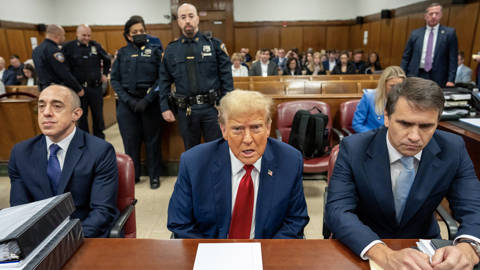Alison L. LaCroix
Says More…
This week in Say More, PS catches up with Alison L. LaCroix, Robert Newton Reid Professor of Law at the University of Chicago and the author of The Interbellum Constitution: Union, Commerce, and Slavery in the Age of Federalisms.
Project Syndicate: Texas has revived the age-old debate about American federalism by enforcing its own immigration policy. You recently wrote that many commentators have been “invoking the past to justify their positions” in that debate. But, as you warn in your new book, The Interbellum Constitution: Union, Commerce, and Slavery in the Age of Federalisms, even scholars of constitutional law tend to misunderstand “the process of constitutional change,” as they focus excessively on “shocks and moments.” What does their approach miss, and what are the practical consequences of this misunderstanding?
Alison LaCroix: A majority of the US Supreme Court’s justices have embraced “originalist” and “textualist” methods of constitutional interpretation. Moreover, the Court recently developed what it calls a “history and tradition” standard for determining the scope of certain constitutional rights – most prominently, in the domains of reproductive rights and firearms regulation.
But while such approaches claim the authority of history, they are deeply ahistorical. The focus on the Constitution’s text means that attention is paid only to the discrete moments when that text changed. This disregards longer timeframes across which constitutional change has sometimes unfolded over the course of US history.
Consider what I call the interbellum period (1815-61). No constitutional amendments were passed; the text did not change. But people’s understanding of key elements of constitutional law – such as the federal government’s power to regulate interstate and foreign commerce – changed profoundly over that period.
My book refutes several conventional narratives about the US Constitution – namely, that it was fixed in place when it was written in 1787, that it remained unchanged until the Civil War, and that constitutional law consists only of what the text of the Constitution says. It also examines the many different and contested historical meanings of what we now refer to as “federalism,” which is central to countless high-profile political disputes in areas ranging from immigration to reproductive rights to election law.
PS: You warn in your commentary that, “[r]eviving arguments that almost unraveled the Union” during the interbellum period “is a deadly serious business.” With Iowa now also seeking to enforce immigration rules, one might fear a kind of domino effect, with states increasingly challenging the federal government’s authority. How far could this go? Is the US constitutional system at risk of unraveling?
AL: Today, we are witnessing threats to some of the bedrock principles of the US constitutional structure, beginning with the idea of federal supremacy. This rule was laid out in the US Constitution from the very start (1787) in what is known as the supremacy clause: “This Constitution, and the Laws of the United States which shall be made in Pursuance thereof; and all Treaties made, or which shall be made, under the Authority of the United States, shall be the supreme Law of the Land; and the Judges in every State shall be bound thereby, anything in the Constitution or Laws of any State to the Contrary notwithstanding.”
Federal supremacy was contested, stretched, and challenged throughout the interbellum period, and again in the civil-rights era of the mid-twentieth century. But, beginning around the 1960s, most Americans would have said that the issue had been definitively settled by the US Civil War, and reaffirmed by landmark Supreme Court decisions in favor of federal power. Recently, however, the language of “states’ rights” has returned to public debate to a degree that would have been unthinkable a decade or so ago.

SPRING SALE: Save 40% on all new Digital or Digital Plus subscriptions
Subscribe now to gain greater access to Project Syndicate – including every commentary and our entire On Point suite of subscriber-exclusive content – starting at just $49.99.
It is impossible to say how far this will go – few would have predicted what we are seeing today – but it is clear that even principles that seemed to have been settled once and for all cannot be taken for granted.
PS: You begin your “history of antebellum American constitutional thought” with the story of William Wirt, the longest-serving US attorney general (1817-29). How does Wirt’s life illustrate the themes of The Interbellum Constitution, and what lessons should those seeking to interpret the constitution today draw from his story?
AL: When I began writing the book, I already knew that I wanted to build my argument through narrative, in order to bring to life the creativity and conflict of the period. So, rather than simply describing events, I follow a cast of “characters” – that is, historical figures – as they move through particular physical spaces and interact with one another.
I had often encountered Wirt over the years, as he participated in many of the great Supreme Court cases of the early national period. I then learned about his career as a man of letters and his outstanding service as US attorney general. And I realized that his life perfectly illustrates the themes of the book in a number of ways.
Wirt was neither a northerner nor a southerner: he spent his career in Maryland, Washington, DC, and, briefly, Virginia. He was a dedicated official who held executive, legislative, and judicial posts in both state and federal government. And his political views shifted from Jeffersonian Republicanism to a more nationalistic Republicanism to an anti-Jacksonianism so strong that he ran for president as the Anti-Masonic candidate in 1832.
Wirt was a writer, attorney, public servant, reformer, father, husband, and slaveholder. He wasn’t a Supreme Court justice, but he was at the center of the most important debates over Union, commerce, concurrent power, and slavery in 1815-34. He is also such a vividly human character, with virtues and flaws, that I enjoyed spending time in his “company” while I was writing the book.
BY THE WAY . . .
PS: You explain in your book that the theme of “concurrent power” – when the line between federal authority and that of the states is unclear – was “uniquely central to interbellum constitutional discourse.” But whereas concurrent power was viewed as a “real and meaningful alternative” to the binary state-federal opposition, despite the need for constant negotiation, modern commentators tend to treat it as “either impossible or dubious.” What drove support for the ideal of concurrent power in the interbellum period, and should the concept be embraced more readily today?
AL: In the interbellum period, concurrent power was simply a feature of the constitutional system. Early-nineteenth-century Americans were drawn into endless arguments about the concept, because the most urgent issues of public debate at the time – commerce, migration, and slavery – involved conflicts among federal, state, and local power, but the Constitution had left hazy the line between federal and state authority on precisely these subjects. The interbellum generation understood that they could not look to the “Founding Fathers” for clear answers to most pressing political and legal issues of their time. Americans today seem to lack such an understanding.
The US has moved toward a constitutional system with less tolerance for concurrent power. Though we have “cooperative federalism” – when states and the federal government work together to administer programs in domains like health care and education – this is typically viewed as an element of administration, not as a case of true power-sharing among multiple levels of government.
At the level of constitutional law, the relationship between state and federal power has become zero-sum. Current appeals to states’ rights therefore necessarily entail a reduction in federal power.
PS: In your book, you trace how the “landscape of constitutional possibility” shifted during the interbellum period. How has this landscape continued to shift in recent years, and what has been driving this trend?
AL: Two recent shifts in the constitutional landscape are particularly striking.
First, we have re-entered a period in which the Supreme Court itself is the subject of controversy. Its composition, its politicization, and its legitimacy have been subjects of intense public debate since 2016: after Justice Antonin Scalia died, the Republican-controlled US Senate refused to conduct a hearing, let alone a vote, on then-President Barack Obama’s nominee to replace him, Merrick Garland. In 2021, US President Joe Biden created the Presidential Commission on the Supreme Court of the United States, on which I had the honor of serving. The Commission’s final report contains a wealth of historical and legal analysis that ought to be a valuable resource for the public.
The second shift concerns the Supreme Court’s treatment of precedent – the principle of stare decisis. For many years, across wide swaths of doctrine, the Court worked to harmonize its own cases, downplaying changes to legal rules and relying on factual distinctions to explain different outcomes in cases. While this smoothing sometimes felt forced, the value of establishing some semblance of continuity with prior rulings is obvious.
Recently, however, the Court appears to have largely abandoned the presumption of continuity. This phenomenon was evident in landmark cases such as Dobbs v. Jackson Women’s Health Organization (2022), in which the Court overruled Roe v. Wade and held that the Constitution does not confer a right to abortion, as well as in other important cases involving affirmative action, religion, and the administrative state.
PS: Many people foresee serious threats to the US constitutional order arising from the upcoming presidential election. Are they right to be worried?
AL: Yes. As a historian, I tend to look for parallels. Will the 2024 election be analogous to that of 1800, when Thomas Jefferson’s self-described “revolution” triggered a battle between the president and the courts? Or will it look more like the election of 1832, when Andrew Jackson received a mandate for violent expropriation of Native nations’ lands in the name of white men’s “democracy”? What about the election of 1860, when Abraham Lincoln’s victory ended northern appeasement of southern slaveholders, spurring South Carolina to secede from the Union?
Of course, historians know not to assume that events always unfold according to some prior precedent. But the fact that the current moment does not exactly replicate past moments of constitutional crisis does not mean that we are not facing such a crisis; it might just be a new kind.




